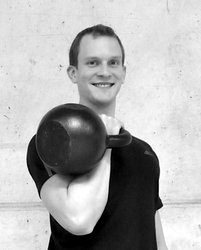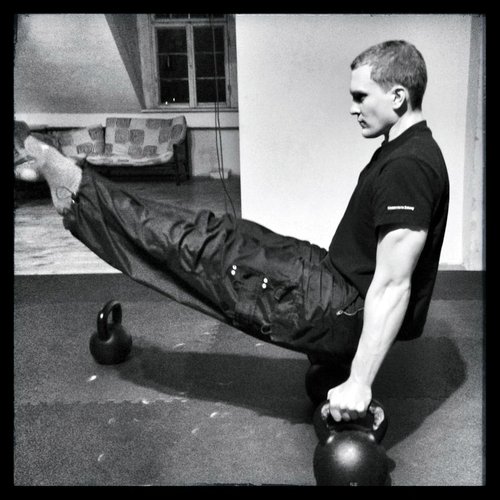Dragon Door: What inspired your early start with strength and conditioning?
Moritz Rammensee: I started strength training at the age of 16 because of bodybuilding. The first training routine I did was a bodybuilding-based five day split. This was my first contact with lifting weights. I didn't have a coach or teacher, but trained by myself or with a good friend.
After finishing school at age 18, I chose to work for the community as a licensed fitness coach. In Germany, when you finish school you either serve in the military for at least one year or do something for the community. I studied on my own, then tested for three days in a row to get my license. I used what I studied to improve my own training and the training I was doing with my friends. Soon more friends started coming to me for programs and tips for strength and conditioning. I had fun helping them, and after hearing them say I was doing a good job, I began to consider
fitness training as a career.
Two years later, I met a personal trainer from Munich who was coaching a friend of mine. I’ve played basketball with this friend since we were very young and noticed he’d gotten a lot bigger and stronger. At the time I was beginning to struggle with my standard fitness programs and realized this personal trainer must be doing something right.
After being introduced, I hired him to coach me. Soon, he asked if I would be interested in becoming a personal trainer and working with him in the new business he was just starting. I learned a lot working with him—including all my basic coaching skills. He also introduced me to the
Functional Movement System (FMS), and I went to Holland for an FMS workshop in 2009.
In 2010, I heard that kettlebells fit perfectly with FMS and that someone in Munich was working with them. I was a little skeptical, but attended an HKC to learn more. At the
HKC, I met Robert Rimoczi who was hosting the workshop, and Peter Lakatos who was a master instructor at the time. After passing the HKC and using the information for half a year I realized that the kettlebell and RKC system was very powerful.
I wanted to learn more and signed up to train with Robert twice a week in preparation for the RKC in August of 2012. I went to the to the
RKC in Hungary with a handful of other guys from "Team Germany". I had put a lot of pressure on myself, because I’d signed up for the CK-FMS in the following December. Thankfully I passed, because I ended up loving the CK-FMS workshop too!
Dragon Door: What made you the most skeptical about kettlebells at first?
Moritz Rammensee: Before kettlebells, I was lifting heavy weights for 1.5-2 hours, 5 days a week and having decent progress. When someone came along and said that I could swing a
16kg kettlebell for 15 minutes and have the same effect, I didn’t believe it. I was so skeptical that I didn't even want to try it, but I eventually did and realized it worked. I became more flexible and injury resistant, especially since my old attitude towards training had been "go hard or go home." The pain in my knees and wrists cleared up with the lighter kettlebell ballistic training.
My mobility went through the roof just from practicing swings and get-ups. I went from doing really hard training for long sessions to hard training but spending only ¼ of the time—and getting a lot better. That experience convinced me!
Dragon Door: How did you decide to continue to RKC-II?
 Moritz Rammensee:
Moritz Rammensee: That was a different type of decision. I basically decided to go for the RKC Level II for a business reasons. In 2012, we had only about 14 RKC instructors in Germany, just one RKC Level II, and one Senior RKC,
Robert Rimoczi. In September, we will have the first ever RKC workshop in Germany, and I know many of the people attending because I’ve helped some of them prepare. Right now in Germany, I am one of only 14 RKCS, after September, I would have been one of a much larger group, so I wanted to position myself a little higher. I decided that since I still wanted to be in the RKC community, I wanted to go for the information and distinction of the RKC-II.
I also wanted to have a specific goal. In 2012 my goal was to become an RKC. I wanted to work for RKC-II in 2013, and now in 2014 I have even more goals!
Dragon Door: What do you like about Dragon Door’s RKC?
Moritz Rammensee: My first RKC workshop was with Pavel, and it was very hardcore. On my feedback form for the
RKC Level II certification, I wrote that at my first RKC workshop I was more worried about sitting up straight and being exactly on time than actually listening and learning—because of the hard Russian style of teaching. The recent RKC-II had a much more relaxed environment, and a great learning atmosphere. It was one of the best workshops, like the CK-FMS. The CK-FMS had the same type of relaxed atmosphere, and Brett Jones was just amazing.
The recent RKC-II was just great, and the people were much more relaxed than in Hungary. I like Dragon Door’s current RKC very much, it’s similar to the way I approach my clients. If a client comes to me with a problem, I am there to help them and will find a way to help them. That's how I see the RKC now, we are willing to find a way to help people and not just tell them to fix their problem before coming back to us. To me that's the big difference.
Dragon Door: And now you’ve opened a gym with Robert Rimoczi and Steven Graves?
Moritz Rammensee: Most of what I knew about kettlebells before the RKC workshop I learned from Robert. Before the RKC, I met
Steven Graves at some of the same training sessions at Robert’s gym. Steven also lives in Munich and was an HKC at that time. Soon, we began to talk about our future plans. I was only training a little group and a few personal training clients, but Steven and I thought small group training would be more profitable and fun. I enjoy personal training, but group training is just a lot more fun in my opinion.
For a while, Steven and I shared a location in Munich by training separate groups at different times. Last summer we decided to try training in the park since kettlebells are perfect for outdoor training. By combining our groups, we thought it would also attract more attention and help us promote our kettlebell training. Back in September of 2012, Robert had the idea to open a large gym in Munich based on RKC-style training. After some difficulties with various locations, it finally worked out for the three of us to open the gym together. After redoing the floor, we moved in and are now training our groups at the new gym.
Dragon Door: Can you tell us about the programming for your training groups?
Moritz Rammensee: Robert had the idea of building a system for all the RKC instructors in Germany, and now we are all working with it at our gym. The first step is our Enter the Kettlebell Seminar—a 3-hour end-user seminar where we introduce the swing and Turkish get-up. Next are our twice-a-week beginner courses, which run for 10 weeks and focus on the basics. At the end of the 10 weeks, we test our students on their technique using the
RKC instructor style criteria. If they pass, they earn a "kettlebell driving license". Then they can attend our regular classes are based on the ideas in Max Shank’s workout templates. These regular classes are basically focused on power work, upper and lower body push and pull, mobility exercises, core work, and conditioning mixed together.
Dragon Door: What's your favorite kettlebell exercise?
Moritz Rammensee: The bottoms-up military press, because it’s self-limiting and self-correcting. I think it’s the best way to fix your pressing groove. If you can't keep your forearm vertical during a heavy bottoms-up press, then it’s impossible to even do the press at all. Also, if your core is not engaged and you're not tight as hell then you won’t make the bottoms-up press. Of course it transfers to the normal military press too, and I like pressing a whole lot.
Dragon Door: Earlier you mentioned having some new goals, what are they?
Moritz Rammensee: Professionally, my goal for 2014 was to become a team leader—and now I am here! But there are many things I need to do with the new gym. Getting it up and running is my main goal for 2014. My athletic goals are not that impressive: a 2.5x bodyweight barbell deadlift, a 2x bodyweight back squat, and a 1.5x bodyweight barbell clean. I also want to be able to do a
freestanding handstand push-up, because I can do handstand push-ups with support, and I can do a free handstand, but not a free handstand push-up! And, I want to do a backflip!
 Dragon Door:
Dragon Door: I remember you attended the Sweden PCC, what did you think of the workshop, and how are you using progressive calisthenics in your training?
Moritz Rammensee: The PCC was really different compared to the systematic approach of the RKC. The atmosphere was great, the people were great, and the spirit was just phenomenal. I’m including freestanding handstands in almost every one of my workouts, and practice handstand push-ups twice a week. I am horribly bad at
bridges but am trying to do them too!
Dragon Door: I noticed on your bio that you like to call your clients everyday athletes—what inspired that phrase?
Moritz Rammensee: I see every one of my clients as a potential athlete, so I want to help them be as prepared as possible for their daily needs. Everyone should be more mobile, stronger, and have less risk of injury. If I am training an elderly woman, I see her as an athlete in mastering her daily life. Lifting heavier things from the floor, or just using the stairs is difficult for some people—I want to make my clients better so that they have easier and more enjoyable lives. They shouldn’t have to worry about having to stop and take a breath after 3 stairs, I want them to just walk up the stairs and be happy.
Dragon Door: Do you train a particular age group more than others?
Moritz Rammensee: No, I've trained people aged 18 up to the oldest person in our RKC training group who is 74.